lategamer
Writer, Sailor, Filmmaker, Irishman,
- Joined
- Dec 7, 2021
- Messages
- 1,887
- Reaction score
- 4,156
I'm writing a new cross-dimensional game (which may be somewhat based on The Long Stair concept) and I'm writing about the first humanoid race the PCs would come into contact with.
I'm thinking about how in traditional fantasy (european) humans tend to meet (european) dwarves and (european) elves. I'm thinking about how we just accept these things. We want some familiarity, cultural touch-points, obviously and we have the legacy of Tolkein and D&D which reinforces this. when I say 'dwarf', people think about Gimle. when I say elf, they likely think of Legolas...or perhaps the more diminutive elves of D&D.
There were some tropes I want to introduce to this alien world and some I don't. I like the idea of there being greater heteromorphology between the cultures of the world. As Humans are a new introduction to the world there's no reason to think there would be the possibility of 'half elves' with human and elf parents. (One of the things I dislike about Avatar 2 - they have human-Na'vi hybrids)
So, I guess the topic I'm talking about is your demihuman cultures. How different are they? Do you attach to real world cultures? do you just take the vanilla approach? What's special about your demi-humans??
I'm thinking about how in traditional fantasy (european) humans tend to meet (european) dwarves and (european) elves. I'm thinking about how we just accept these things. We want some familiarity, cultural touch-points, obviously and we have the legacy of Tolkein and D&D which reinforces this. when I say 'dwarf', people think about Gimle. when I say elf, they likely think of Legolas...or perhaps the more diminutive elves of D&D.
There were some tropes I want to introduce to this alien world and some I don't. I like the idea of there being greater heteromorphology between the cultures of the world. As Humans are a new introduction to the world there's no reason to think there would be the possibility of 'half elves' with human and elf parents. (One of the things I dislike about Avatar 2 - they have human-Na'vi hybrids)
So, I guess the topic I'm talking about is your demihuman cultures. How different are they? Do you attach to real world cultures? do you just take the vanilla approach? What's special about your demi-humans??





